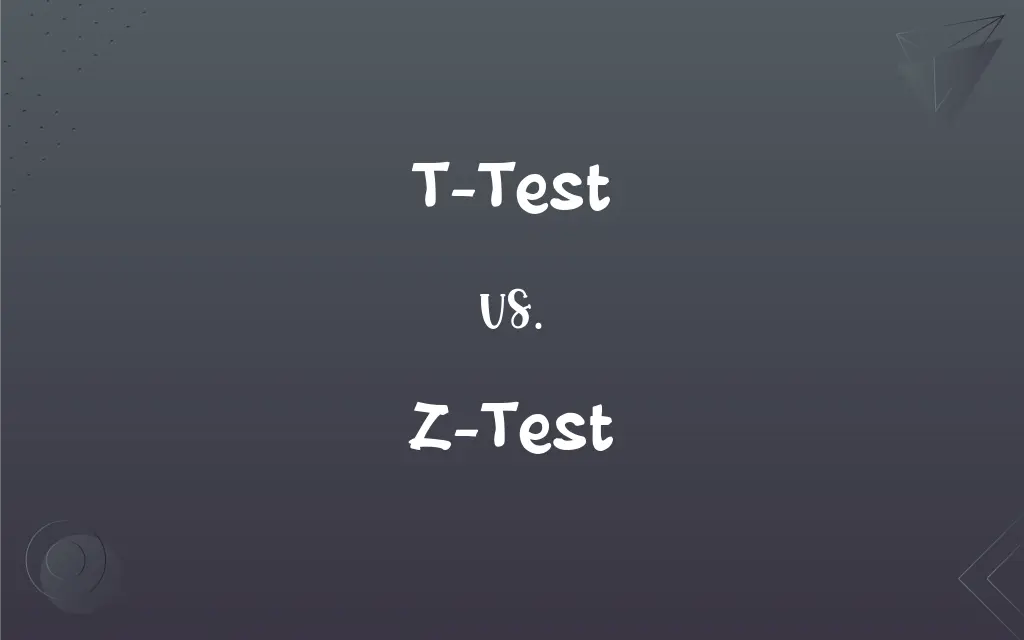T-Test vs. Z-Test: What's the Difference?
Edited by Aimie Carlson || By Janet White || Published on February 20, 2024
T-Test assesses means of two groups with unknown variances, typically for small samples. Z-Test evaluates population means with known variance, usually for large samples.

Key Differences
T-Test and Z-Test are both statistical methods used to test hypotheses. The T-Test is often used when the data sample is small and the population variance is unknown. In contrast, the Z-Test is applied for large sample sizes when the population variance is known.
The T-Test is particularly useful in situations where the sample size is less than 30. It is more adaptable to smaller samples where the Central Limit Theorem doesn't hold. The Z-Test, however, is suitable for larger samples, typically over 30, where the sample mean tends to normally distribute, making the Z-Test a good fit.
In T-Test, the test statistic follows a T-distribution under the null hypothesis. This is a consequence of the unknown population variance, which requires estimation from the sample. The Z-Test, on the other hand, uses a Z-distribution (normal distribution) for the test statistic, applicable when the population variance is known and the sample size is large.
The T-Test includes various types like the one-sample, two-sample, and paired T-Test, each suited for different experimental designs. The Z-Test, while generally simpler, is mainly used for comparing sample and population means, and for testing proportions in large samples.
For both T-Test and Z-Test, statistical significance is determined by comparing the p-value with a threshold (alpha level). However, due to the different distributions used, the specific critical values and interpretation of results may vary between the tests.
ADVERTISEMENT
Comparison Chart
Sample Size
Typically used for small samples (<30).
Ideal for large samples (≥30).
Variance
Used when population variance is unknown.
Applied when population variance is known.
Distribution
Follows a T-distribution.
Follows a Z-distribution (normal distribution).
Types
Includes one-sample, two-sample, paired.
Mainly for sample vs population mean, proportions.
Usage Context
More common in academic and research settings.
Often used in quality control, large surveys.
ADVERTISEMENT
T-Test and Z-Test Definitions
T-Test
T-Test assesses differences in means between two groups.
Researchers used a T-Test to compare the effectiveness of two medications.
Z-Test
Z-Test compares the mean of a sample to a known population mean.
A Z-Test was used to determine if the factory's output was different from the industry standard.
T-Test
T-Test determines if a sample is significantly different from the population.
A T-Test showed that the sample's average age significantly differed from the national average.
Z-Test
Z-Test is utilized for testing the proportion in large samples.
To analyze voter preference, a Z-Test was applied to the survey data.
T-Test
T-Test compares the mean values of two related samples.
To evaluate the before-and-after effects of a diet, a paired T-Test was used.
Z-Test
Z-Test is ideal for hypothesis testing in large sample sizes.
A Z-Test confirmed that the new process significantly increased production efficiency.
T-Test
T-Test evaluates the impact of an intervention in experimental studies.
A T-Test was conducted to analyze the impact of a new teaching method on student performance.
Z-Test
Z-Test assesses whether two population means are different when variances are known.
The Z-Test revealed no significant difference in average heights between the two regions.
T-Test
T-Test is a parametric test based on mean and standard deviation.
The T-Test indicated significant differences in average incomes between the two cities.
Z-Test
Z-Test uses the normal distribution for statistical inference.
The Z-Test showed that the medication's success rate was above average.
T-Test
(statistics) Student's t-test
FAQs
Is Z-Test applicable for small samples?
Z-Test is not ideal for small samples as it assumes a known population variance and a normal distribution which might not hold in small samples.
Can T-Test be used for large samples?
While T-Test is best for small samples, it can be used for larger samples, but Z-Test is more appropriate in such cases.
What is a T-Test?
T-Test is a statistical test used to compare the means of two groups, especially when the sample sizes are small and variances are unknown.
What types of T-Tests are there?
There are one-sample, two-sample, and paired T-Tests, each for different experimental setups.
How does sample size affect the choice between T-Test and Z-Test?
Sample size is crucial; use T-Test for smaller samples and Z-Test for larger ones.
Can Z-Test be used for two independent samples?
Yes, Z-Test can compare two independent population means, provided the sample sizes are large and variances are known.
What if population variance is unknown for a large sample?
If the variance is unknown, even in large samples, a T-Test might be more appropriate.
How do variances impact the choice of test?
T-Test is used when variances are unknown and estimated from the data, while Z-Test requires known variances.
When should I use a Z-Test?
Use a Z-Test for large sample sizes (30 or more) when you know the population variance.
Is T-Test only for normal distributions?
T-Test assumes a normal distribution, but it's robust to some deviations, especially in larger samples.
How are T-Test and Z-Test related to hypothesis testing?
Both are used in hypothesis testing to determine if there are significant differences between groups or between a sample and a population.
Why is Z-Test more common in quality control?
Z-Test is used in quality control due to large sample sizes and known population parameters.
Are there online tools to perform T-Test and Z-Test?
Yes, there are various online calculators and statistical software that can perform these tests.
What is the significance level in T-Test and Z-Test?
The significance level, typically set at 0.05, is the threshold for determining statistical significance in both tests.
What does the ‘T’ in T-Test stand for?
The 'T' in T-Test refers to the T-distribution, which the test statistic follows.
Does Z-Test require normality?
Z-Test assumes a normal distribution, which is generally met in large sample sizes due to the Central Limit Theorem.
Can T-Test and Z-Test results differ?
Yes, especially in small samples, due to the difference in distribution assumptions.
Can T-Test be used for paired data?
Yes, the paired T-Test is specifically designed for comparing two related samples.
Can I use T-Test for non-parametric data?
No, T-Test is a parametric test; for non-parametric data, consider other tests like the Mann-Whitney U test.
What is the main difference in the distribution between T-Test and Z-Test?
T-Test uses the T-distribution, which adjusts for smaller samples, while Z-Test uses the normal distribution, suitable for larger samples.
About Author
Written by
Janet WhiteJanet White has been an esteemed writer and blogger for Difference Wiki. Holding a Master's degree in Science and Medical Journalism from the prestigious Boston University, she has consistently demonstrated her expertise and passion for her field. When she's not immersed in her work, Janet relishes her time exercising, delving into a good book, and cherishing moments with friends and family.
Edited by
Aimie CarlsonAimie Carlson, holding a master's degree in English literature, is a fervent English language enthusiast. She lends her writing talents to Difference Wiki, a prominent website that specializes in comparisons, offering readers insightful analyses that both captivate and inform.







































































